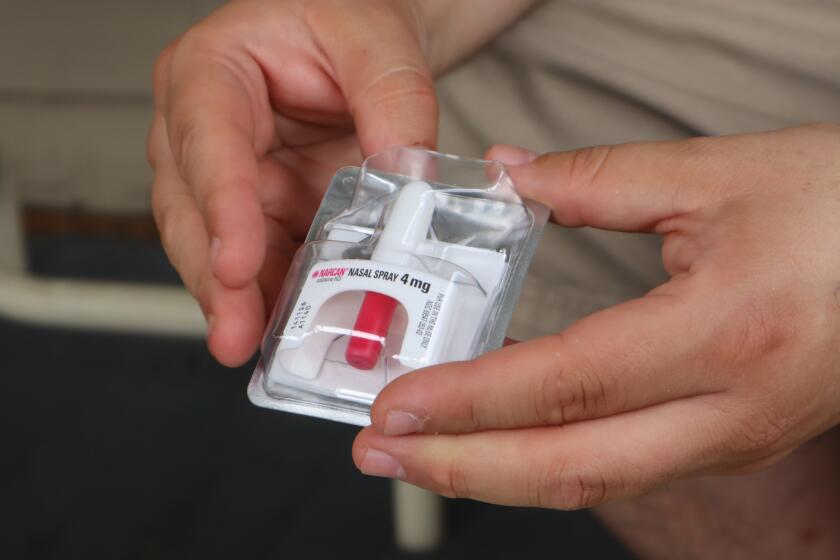California programs are waiting weeks for free Narcan to prevent overdose deaths

After losing her son Luke to an overdose, Sheila Scott has been trying to get “revenge on death,” she said.
Scott founded the Lukelove Foundation and has been teaching families how to use Narcan, a nasal spray containing naloxone that can reverse the deadly effects of opioids. If the medication had been around when her son overdosed, Scott said, things could have been different.
“It’s like creating an army,” Scott said of her trainings. Whenever she hears back from someone that they used Narcan to save a life, “I’m dancing around the kitchen.”
But as the overdose crisis has deepened, so has the demand for naloxone in California — and the pinch is being felt by community groups. Like many in California, Scott orders Narcan through a state program that provides the lifesaving medication for free to community groups, emergency responders, law enforcement and other eligible agencies.
Scott said her naloxone orders used to be turned around in two weeks or less, but her last order took nine weeks before it arrived in October. She had run out of Narcan from the state program at the end of August and was worried about whether she would have to dip into her own personal funds.
As of this fall, the California Department of Health Care Services estimated that wait times for the medication were averaging four to six weeks. By the beginning of October, DHCS had received more than 2,000 applications for free naloxone this year — more than twice as many as it received the entire year of 2019.
State officials attributed the surging demand to the rising rate of overdoses, which has increased calls to get more Narcan into communities so that it can be readily used to rescue people. The medication binds to the same receptors in the brain as opioids, reversing or blocking their effects.
Unsure about her Narcan supply, Scott held off on answering new requests for trainings. She ended up getting a donation from a company that makes Kloxxado — another nasal spray with a higher amount of naloxone — and had also turned to another nonprofit, End Overdose, for enough Narcan to do a training that was already scheduled in Thousand Oaks.
End Overdose, in turn, said it has relied on donations to buy additional doses to keep training thousands of people every month. The state caps how much free Narcan can be ordered at a time, limiting each order to 2,100 units. The cap had been set at 2,400 units but was lowered in September 2021 due to the growing demand, according to the Department of Health Care Services. Each unit contains two doses of Narcan nasal spray.
“What we really need right now is 4,200 units a month” in California, said Theo Krzywicki, chief executive of End Overdose. Because each order can take six weeks to arrive, End Overdose has to buy more naloxone itself each month — and that means holding off on launching new programs and services, Krzywicki said.
The state and L.A. County have worked hard to make Naloxone more widely available. One of the hurdles, though, has been the price of the inhalable version, Narcan.
If the nonprofit needs 1,000 more boxes, “you have to pay $47,000,” he estimated. “It’s cutting into other areas of your program.”
More than 100,000 people die annually of drug overdoses in the United States, and roughly 80,000 of those deaths are tied to opioids, according to the most recent data from the National Center for Health Statistics. Across the country, naloxone has been increasingly embraced as a crucial tool for saving lives, with states passing laws to make it easier for ordinary people to access.
Among them, California “is one of the states that’s on the forefront of naloxone access,” said Amy Judd Lieberman, senior attorney with the Harm Reduction Legal Project at the Network for Public Health Law. Its laws allow naloxone to be prescribed and dispensed to people who are not at risk of overdose, so that they can assist others.
The California Department of Public Health has also issued a “standing order” for providing naloxone, which community groups can apply to use, rather than having to turn to a healthcare provider. And its Department of Health Care Services launched its project to provide the medication for free to eligible groups.
The Naloxone Distribution Project run by DHCS had distributed more than 1.5 million units of naloxone by the middle of October, which were credited with reversing more than 100,000 overdoses. Harm reduction organizations such as syringe exchanges had gotten under a third of the boxes so far but accounted for two-thirds of the reported reversals, according to state figures.
“It’s a super valuable program,” Krzywicki said. “I don’t think the problem is with the program. I think that they just need more support.”
This budget year, the program had $52 million in funding, including state, federal and one-time opioid settlement money, according to the Department of Health Care Services. Before then, it did not get money allocated in the state budget but had received more than $100 million in federal grants since 2017, the department said.
DHCS stressed that the program is not the only source in California for naloxone and that purchases have also been funded by grants and opioid settlement money at the local level.
Three years ago, California applicants sought more than 373,000 units of Narcan in a single year from the program, and the state sent out nearly 202,000 of them. This year, applicants had already asked for more than 688,000 units by the beginning of October and had received roughly 530,000 of them.
In some cases, DHCS said it has had to whittle down requested orders below the 2,100-unit cap to accommodate the growing demand and ensure that it does not overrun weekly limits on program spending, which are meant to ensure that it can consistently provide naloxone throughout the year.
In San Diego County, Nathan Smiddy distributes Narcan with the nonprofit Humanity Showers. He said his organization has applied for the maximum amount of Narcan allowed under the caps because “it goes as fast as you can give it.” He wants to give it out freely, since “it’s better to have it and not need it, than need it and not have it.”
But Smiddy said that the state has given the group less Narcan than it requested, forcing him to ration the supplies. He wrestles with how much to give people, especially to those who are not actively using drugs but want to have it on hand for emergencies. “I really have to think about that. Can they get by with less?” Smiddy said.
“It makes me feel like I’m not serving my people,” he said. “I’m always worried about, ‘What if I didn’t get them enough?’”
Under the proposal unanimously approved by L.A. County supervisors, libraries could supply naloxone and teach librarians how to administer it.
In addition to growing demand for naloxone, production problems squeezed the available supplies earlier in the pandemic. Last year, Pfizer halted production of its single-dose injectable version of naloxone, citing manufacturing issues. Pfizer had been providing the injectable medicine at a discount to Remedy Alliance, which connects harm reduction programs across the country to affordable naloxone.
“There were other manufacturers that make naloxone, but it was not available at a price that was affordable to harm reduction programs,” said Eliza Wheeler, co-director of Remedy Alliance. Before the Pfizer stoppage, Wheeler said her organization had been providing between 100,000 and 200,000 doses annually to California groups.
Pfizer has since started producing the injectable doses again, and Remedy Alliance has also mobilized to start getting injectable naloxone to harm reduction groups through another manufacturer. But the earlier shortage had put more pressure on other sources of naloxone, such as the California program.
In addition to the hundreds of thousands of units of Narcan distributed annually, the state program has also sent out 37,000 doses since August of injectable naloxone, which is available to harm reduction groups without caps. The injectable version of the medication is much cheaper — California pays $3 per vial versus $47.50 for a two-dose kit of Narcan, according to the healthcare services department — and has been around longer than the nasal spray.
Wheeler said in the early days of naloxone distribution, the main recipients were people who had experience using drugs, and “there was very little discomfort with the use of an injectable product.” But as naloxone distribution has expanded to others who could intervene to save a life, many are more comfortable with a nasal spray, even though Wheeler argued that the injectable form is little different than other commonly injected medications such as insulin.
Smiddy, who does naloxone trainings in San Diego, said some people who use drugs prefer the injectable version because it is less likely to abruptly put people into withdrawal. But “laypeople — they want the nasal,” he said. “It’s going to be a learning curve getting a lot of people on board with it.”
Scott said that for the groups she is training, nasal spray needs to be readily at hand.
“You can’t be in the middle of this crisis and people are running short on Narcan,” she said.
More to Read
Sign up for Essential California
The most important California stories and recommendations in your inbox every morning.
You may occasionally receive promotional content from the Los Angeles Times.













